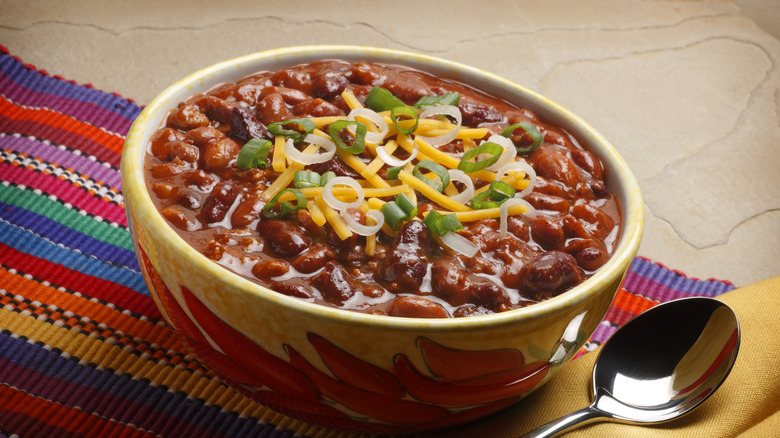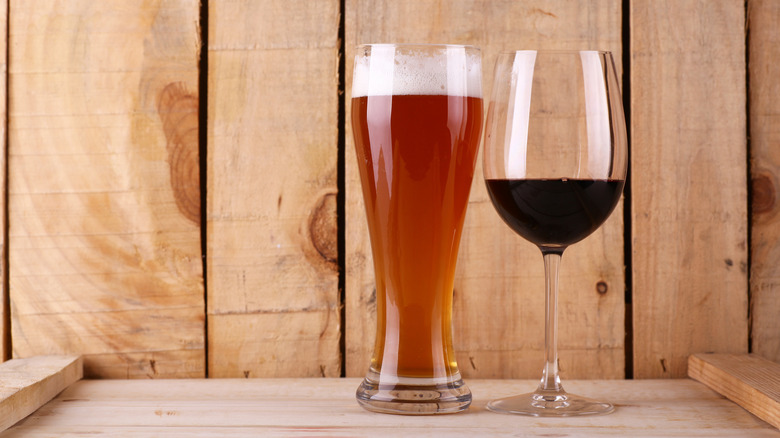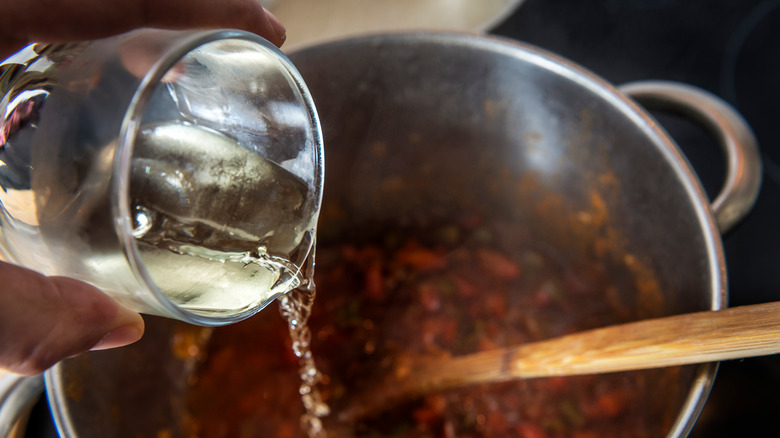Seriously Upgrade Your Chili With A Boozy Ingredient
Whether you like Texas chili, Indiana Hoosier chili, or vegetarian varieties, a heaping pot of chili is a tried-and-true comfort meal that will warm you up and keep you sated. Among the many reasons to love the dish is its versatility. You can spice it up, keep it tame, or otherwise tweak it to satisfy your specific cravings. While there are numerous ways to give chili a boost, one of the most compelling is adding booze. For one thing, it's practical, given that it's ideal for deglazing the pan and incorporating those crispy browned bits of fond back into the stew. No matter if you choose beer, wine, or something stronger, alcohol is a boon to chili's long-simmered flavors.
For instance, instead of adding just water or broth to your preferred recipe, pouring in some of your favorite beer will impart rich, malty, pleasantly bitter, and hoppy nuances for a resulting dish brimming with robustness and complexity. Plus, beer's enzymes and slight acidity help tenderize tougher meats, rendering cuts like chuck roast and oxtail more succulent and easier to shred.
Let your taste buds be your guide when choosing which beer to use. Stouts like Guinness can infuse your chili with deep, roasted coffee notes, while amber ales offer a balanced combination of malt sweetness and hoppy bitterness. Extra-hoppy IPAs are great for absorbing lots of peppery heat. Meanwhile, light lagers will bring a more subtle aroma to your chili.
Not a beer fan? Don't whine, grab wine
Of course, not everyone loves beer — and that's okay! You can always raid your wine rack instead.
Like beer, wine adds depth and a poignant layer of richness to the flavor profile of your homemade chili. Depending on your selection, it can contribute fruity, floral, and even earthy notes that seamlessly complement the dish's components. Wine is also more naturally acidic than beer, so it both balances the chili's heartiness and brightens its overall taste, which is particularly useful in recipes containing fatty proteins and other decadent savory ingredients. And as with beer, wine's acidity is excellent for softening the collagen and connective tissues in tough cuts of meat.
From the stonefruit notes of merlot to the bold and tannic characteristics of cabernet sauvignon and the refreshing, crisp essence of pinot grigio, your options are virtually endless when it comes to which grapes will be chums with your chili. Fortified wines like port, vermouth, and sherry are also fair game — especially when pairing their bolder taste with similarly robust game meats like venison and wild boar.
You also have options regarding when and how to add wine to your chili. Pouring it straight from the bottle early in the cooking process is one way; another is cooking the wine to concentrate and thicken it before stirring it into your pot as a finishing touch like demi-glace.
Precautions and tips
If you're going to cook boozy chili, there are precautions and tips to keep in mind to maximize your efforts. For starters, when you add booze during cooking, the alcohol content evaporates, so you won't catch a buzz from your meal. While your chili's strength is ultimately at your discretion, if you're concerned about it becoming overly alcoholic, using equal parts broth and booze will help balance things out.
You can also ease up on the amount of alcohol for an even mellower kick, discouraging any potentially overpowering aromas and flavors in favor of a subtler edge. This is especially helpful when following recipes that call for higher ABV liquors like tequila or whiskey. Don't be too shy with them, though. As Chef Ouita Michel told VinePair, "The reason I like to add bourbon is that it adds a lot of very complementary spice notes to chili."
You should also ensure that the booze you choose doesn't clash with the specific ingredients in your chili. For instance, an earthy, full-bodied wine that pairs well with beef may not be the best choice for a vegetarian chili. Once you've made your selection, consider a longer cooking time than usual to allow the ingredients to develop and meld together. If you're unsure where to start, you can always try your hand at a classic beer-infused game-day chili. Or go for something lighter and unique, like mushroom chicken marsala chili with white beans.


